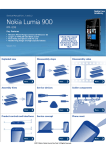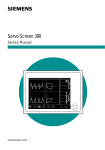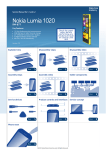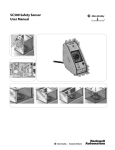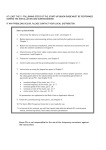Download vacon 100 optbj safety manual
Transcript
vacon 100 ® ac drives optbj sto and atex option board safety manual vacon • 1 TABLE OF CONTENTS Document: DPD00470C Release date : 20022015 1. 2. Approvals.........................................................................................................2 General ............................................................................................................8 2.1 References .........................................................................................................................9 3. 4. Installation of OPTBJ board ...........................................................................10 OPTBJ board layout........................................................................................13 4.1 4.2 OPTBJ board jumpers......................................................................................................13 STO jumpers on the Vacon 100 drive ...............................................................................14 5. STO and SS1 safety functions .........................................................................15 5.1 5.2 5.3 5.3.1 5.3.2 5.3.3 5.3.4 5.3.5 Safe Torque Off (STO) principle .......................................................................................15 Safe Stop 1 (SS1) Principle ..............................................................................................18 Technical details ..............................................................................................................20 Response times................................................................................................................20 Connections......................................................................................................................20 Relay output .....................................................................................................................21 Safety-related data according to the standard ...............................................................21 Wiring examples ..............................................................................................................23 6. Commissioning ..............................................................................................26 6.1 6.2 6.3 General wiring instructions .............................................................................................26 Checklist for commissioning the OPTBJ board...............................................................27 Testing the Safe Torque Off (STO) or Safe Stop 1 (SS1) safety functions .......................28 7. Maintenance...................................................................................................29 7.1 Faults related to the Safe Torque Off (STO) or Safe Stop 1 (SS1) safety functions ........29 8. Thermistor function (ATEX) ...........................................................................31 8.1 8.1.1 8.1.2 8.1.3 8.1.4 8.2 8.2.1 8.2.2 Technical data ..................................................................................................................34 Functional description .....................................................................................................34 Hardware and connections ..............................................................................................34 Atex function ....................................................................................................................34 Short circuit monitoring...................................................................................................35 Commissioning ................................................................................................................36 General wiring instructions .............................................................................................36 Fault diagnosis of thermistor function ............................................................................36 NOTE! You can download the English and French product manuals with applicable safety, warning and caution information from www.vacon.com/downloads. REMARQUE Vous pouvez télécharger les versions anglaise et française des manuels produit contenant l’ensemble des informations de sécurité, avertissements et mises en garde applicables sur le site www.vacon.com/downloads. 24-hour support +358 (0)201 212 575 • Email: [email protected] vacon • 2 1. 1 Approvals APPROVALS Tel. +358 (0) 201 2121 • Fax +358 (0)201 212 205 Approvals 24-hour support +358 (0)201 212 575 • Email: [email protected] vacon • 3 1 vacon • 4 1 Approvals Tel. +358 (0) 201 2121 • Fax +358 (0)201 212 205 Approvals 24-hour support +358 (0)201 212 575 • Email: [email protected] vacon • 5 1 vacon • 6 1 Approvals Tel. +358 (0) 201 2121 • Fax +358 (0)201 212 205 Approvals 24-hour support +358 (0)201 212 575 • Email: [email protected] vacon • 7 1 vacon • 8 2. General GENERAL NOTE! These are the original instructions. NOTE! Designing of safety-related systems requires special knowledge and skills. Only qualified persons are permitted to install and set up the OPTBJ board. This document covers the OPTBJ option board 70CVB01380 functionality together with Vacon 100 Control board 70CVB01582. The OPTBJ option board together with Vacon 100 control board provides the following safety functions with Vacon 100 products. The following safety-related abbreviations and expressions have been used in this manual: SIL Safety Integrity Level PL Performance Level PFH Probability of a dangerous random hardware Failure per Hour Category Designated architecture for a safety function (from EN ISO 13849-1:2006) MTTFd Mean time to dangerous failure DCavg Average diagnostic coverage PFDavg Average probability of (random hardware) failure on demand TM Mission time Safe Torque Off (STO) The hardware based 'Safe Torque Off' safety function prevents the drive from generating torque on the motor shaft. The STO safety function has been designed for use in accordance with the following standards: • • • • • • EN 61800-5-2 Safe Torque Off (STO) SIL3 EN ISO 13849-1 PL"e" Category 3 EN 62061: SILCL3 IEC 61508: SIL3 The function also corresponds to an uncontrolled stop in accordance with the stop category 0, EN 60204-1. The STO safety function has been certified by TÜV Rheinland * NOTE! The STO function is not the same as a prevention of unexpected start-up function. For fulfilling those requirements, additional external components are required according to appropriate standards and application requirements. Required external components may be for example: • Appropriate lockable switch • A safety relay providing a reset function NOTE! The safety functions of OPTBJ do not comply with Emergency Switching Off according to EN 60204-1. NOTE! Do not use the STO function as a standard stop function of the drive. NOTE! In an IGBT fault situation, the shaft of a permanent magnet motor can rotate up to 180 degrees around the pole of the motor. NOTE! If the pollution degree 2 cannot be guaranteed, use the IP54 protection class. 13006.emf 2 CAUTION! The OPTBJ board and its safety functions do not electrically isolate the drive output from the mains supply. If electrical work is to be carried out on the drive, the motor or the motor cabling, the drive has to be completely isolated from the mains supply, for example, using an external supply disconnecting switch. See, for example, EN60204-1 Chapter 6.3. Tel. +358 (0) 201 2121 • Fax +358 (0)201 212 205 General vacon • 9 Safe Stop 1 (SS1) The SS1 safety function is realized in compliance with type C of the drives safety standard EN 618005-2 (Type C: "The PDS(SR) initiates the motor deceleration and initiates the STO function after an application specific time delay"). The SS1 safety function has been designed for use in accordance with the following standards: • • • • • EN 61800-5-2 Safe Stop 1 (SS1) SIL2 EN ISO 13849-1 PL"d" Category 3 EN 62061: SILCL2 IEC 61508: SIL2 The function also corresponds to a controlled stop in accordance with the stop cat. 1, EN 60204-1. Motor Thermistor Over temperature protection (according to ATEX) Overtemperature detection using thermistor. It can be used as a tripping device for ATEX certified motors. The thermistor tripping function is certified by VTT** according to ATEX directive 94/9/EC. All safety functions of the OPTBJ board are described in this manual. ** VTT = Technical Research Centre of Finland 2.1 References Vacon 100 Installation and Application manuals are downloadable at www.vacon.com -> Support & downloads -> Vacon manuals -> Vacon 100 manuals. 24-hour support +358 (0)201 212 575 • Email: [email protected] 2 vacon • 10 3. Installation of OPTBJ board INSTALLATION OF OPTBJ BOARD Open the cover of the AC drive. M4x55 1 11573_00 The relay outputs and other I/O-terminals may have a dangerous control voltage present even when Vacon 100 is disconnected from mains. 9000.emf 2 Slot coding 3040.emf NOTE: Incompatible boards cannot be installed on Vacon 100. Compatible boards have a slot coding that enable the placing of the board (see above) 3 Tel. +358 (0) 201 2121 • Fax +358 (0)201 212 205 Installation of OPTBJ board vacon • 11 Open the inner cover to reveal the option board slots and install the OPTBJ board into slot E. Close the inner cover. NOTE! See Chapter 4.1 for the jumper settings! 3 E 3041.emf Using the grounding clamp for control cable included in the delivery of the drive, ground the shield of the OPTBJ cable to the frame of the AC drive. NOTE! Shielded cable must be used. NOTE! Grounding must be done according to best practice. 4 Grounding clamp for control cable 11574A_uk 24-hour support +358 (0)201 212 575 • Email: [email protected] 3 vacon • 12 Installation of OPTBJ board Unless already done for the other control cables, cut free the opening on the AC drive cover for the OPTBJ cable (protection class IP21). NOTE: Cut the opening on the side of the slot E! 5 11576_00 Remount the AC drive cover and run the cable as shown in picture. NOTE: When planning the cable runs, remember to keep the distance between OPTBJ cables and the motor cable at a minimum of 30 cm. It is recommended to route the OPTBJ cables away from the power cables as shown in the picture. 6 OPTBJ cables 11572_uk 3 Tel. +358 (0) 201 2121 • Fax +358 (0)201 212 205 OPTBJ board layout 4. vacon • 13 OPTBJ BOARD LAYOUT Thermistor Input: Thermistor active > 4000 ohm. After being active, the fault can be reset if resistance is < 2000 ohm Jumper for selecting thermistor short circuit supervision Jumper for STO board activation. Place here the 3-pin jumper from the control board. STO JMP X10 TI1+ 28 29 TI1Relay output for STO function STO1+ STO1STO2+ STO2- X23 On Off Thermistor short circuit supervision 25 26 1 2 3 4 3038.emf STO inputs Figure 1. OPTBJ board layout 4.1 OPTBJ board jumpers There are two jumpers on the OPTBJ option board. The jumpers are described below: Jumper X23, short circuit supervision Short circuit supervision ON Short circuit supervision OFF Jumper X10, STO board activation STO board not activated STO board activated, take the 3-pin jumper from the control board, see figure below: = Factory default 3039.emf Figure 2. OPTBJ board jumpers To activate the OPTBJ board, you must take the three-pin jumper from the drive control board and place it to the OPTBJ board jumper X10. See the next chapter for more information. NOTE! If there are problems with the jumpers, see chapter 7.1! 24-hour support +358 (0)201 212 575 • Email: [email protected] 4 vacon • 14 4.2 OPTBJ board layout STO jumpers on the Vacon 100 drive STO JMP 3049.emf Figure 3. STO jumper location on Vacon 100. Open the main cover and the inner cover to reveal the jumper. 4 Tel. +358 (0) 201 2121 • Fax +358 (0)201 212 205 STO and SS1 safety functions 5. vacon • 15 STO AND SS1 SAFETY FUNCTIONS The safety functions of the OPTBJ board, such as the technical principle and data, wiring examples and commissioning, will be described in this chapter. NOTE! The use of STO, SS1 or other safety functions does not itself ensure safety. An overall risk evaluation is required in order to make sure that the commissioned system is safe. Safety devices like the OPTBJ board must be correctly incorporated into the entire system. The entire system must be designed in compliance with all relevant standards within the field of industry. Standards such as EN12100 Part 1, Part 2, & ISO 14121-1 provide methods for designing safe machinery and for carrying out a risk assessment. 13006.emf 5.1 CAUTION! The information in this manual provides guidance on the use of the safety functions that OPTBJ option board provides together with Vacon 100 control board. This information is in compliance with accepted practice and regulations at the time of writing. However, the end product/system designer is responsible for ensuring that the system is safe and in compliance with relevant regulations. Safe Torque Off (STO) principle The STO safety function of the OPTBJ board allows the drive output to be disabled so that the drive cannot generate torque in the motor shaft. For STO, the OPTBJ board has two separate, galvanically isolated inputs STO1 and STO2. NOTE! The STO inputs must be connected to +24V signal so that the drive can go to the enable state. The STO safety function is achieved by disabling the drive modulation. The drive modulation is disabled through two independent paths controlled by STO1 and STO2 so that a single fault in any of the safety related parts will not lead to the loss of the safety function. This is done by disabling the gate driver signal outputs to the driver electronics. The gate drive output signals control the IGBT module. When gate drive output signals are disabled, the drive will not generate torque in the motor shaft. See Figures 4 and 5. 24-hour support +358 (0)201 212 575 • Email: [email protected] 5 vacon • 16 STO and SS1 safety functions VACON 100 CONTROL UNIT OPT-BJ board, slot E + Thermistor Atex Safety Function - RO Control board Atex Safety Function STO1 STO2 POWER UNIT Hardware Hardware STO 1 STO 2 = 3~ 11575A_uk Figure 4.STO principle with OPTBJ board and Vacon 100 control board MR4-10 5 Tel. +358 (0) 201 2121 • Fax +358 (0)201 212 205 STO and SS1 safety functions vacon • 17 VACON 100 CONTROL UNIT OPT-BJ board, slot E + Thermistor Control board Atex Safety Function - Atex Safety Function RO STO1 STO2 SLAVE POWER UNIT MASTER POWER UNIT Hardware Hardware Hardware Hardware STO 1 STO 2 STO 1 STO 2 = = 3~ 3~ 11654_uk Figure 5.STO principle with OPTBJ board and Vacon 100 control board MR12 24-hour support +358 (0)201 212 575 • Email: [email protected] 5 vacon • 18 5.2 STO and SS1 safety functions Safe Stop 1 (SS1) Principle After a safe stop command the motor starts decelerating and SS1 safety function initiates the STO after a user set time delay. Frequency Stop Motor deceleration factual Safe Torque Off (STO) Time delay 0 Time 11578_uk Figure 6. The principle of Safe Stop 1 (EN 61800-5-2, SS1 type c) The Safe Stop 1 (SS1) safety function consists of two safety related subsystems, an external time delayed safety relay and the STO safety function. These two subsystems combined compose the Safe Stop 1 safety function as shown in Figure 7. Safe Stop 1 (SS1) Time Delayed Safety Relay Vacon 100 Safe Torque Off (STO) Subsystem Safety Relay Subsystem STO + 11579_uk Figure 7. Safe Stop 1 (SS1) safety function 5 Tel. +358 (0) 201 2121 • Fax +358 (0)201 212 205 STO and SS1 safety functions vacon • 19 Figure 8 shows the connection principle of Safe Stop 1 safety function, as specified in figure 6. • • The time delayed safety relay outputs are connected to the STO inputs. A separate digital output from the safety relay is connected to a general digital input of the Vacon 100 drive. The general digital input must be programmed to execute the drive stop command and initiates the drive stop function without a time delay (must be set to "stop by ramp") and causes motor deceleration. If the SS1 behavior of Figure 6 is required then it must be ensured that the ramp stop is activated when the stop signal is received. It is the responsibility of the system designer to verify this. Safety Relay with timer Basic I/O Ramp stop Switch Digital input Vacon 100 control OPTBJ board Time delay STO STO channel 1 STO channel 2 Power Unit M 11577_uk Figure 8. The connection principle of Safe Stop 1 (SS1) CAUTION! The system designer/user is responsible for understanding and setting the time delay of the safety relay, as it is process/machine dependent. • • 13006.emf The time delay must be set to a greater value than the deceleration time of the drive*. The motor deceleration time is process/machine dependent. The stop function of the drive needs to be correctly set for the process/ machine. Activating the SS1 safety function must execute the configured stop in the drive. In the Vacon 100 default application software it is recommended to use the "Quick Stop" functionality for this purpose. * In case of a single fault the drive may not ramp down but is only put to STO mode after the configured time delay. CAUTION! The control place must be set according to the application requirements. 13006.emf See Chapter 5.4 concerning the parametrizing of Safe Stop 1 and Chapter 5.3.5 for the wiring of Safe Stop 1. 24-hour support +358 (0)201 212 575 • Email: [email protected] 5 vacon • 20 STO and SS1 safety functions 5.3 Technical details 5.3.1 Response times Safety function DeActivation activation time time Safe Torque Off (STO) < 20 ms 500 ms Table 1. STO response times 5.3.2 Connections In addition to the STO inputs, the board contains also a thermistor input. If the thermistor input is not used, it must be disabled. The thermistor input is disabled by making a short circuit to the terminals and setting the jumper X23 in "OFF" state. The thermistor input operation and instructions are presented in chapter 7.1. Terminal 1 Technical information STO1+ Isolated STO input 1, +24V +-20% 10... 15mA 2 STO1- Virtual GND 1 3 STO2+ Isolated STO input 2, +24V +-20% 10... 15mA 4 STO2- Virtual GND 2 25 RO1 26 RO2 28 TI1+ 29 TI1- Relay output 1 (NO) * Switching capacity: • 24VDC/8A • 250VAC/8A • 125VDC/0.4A Min. switching load: 5V/10mA Thermistor input; Rtrip > 4.0 kΩ (PTC) Table 2. OPTBJ I/O terminals * If 230VAC is used as control voltage from the output relays, the control circuitry must be powered with a separate isolation transformer to limit short circuit current and overvoltage spikes. This is to prevent the welding on the relay contacts. VSTO1+ - VSTO1- VSTO2+ - VSTO2- STO state 0VDC 0VDC STO active 24VDC 0VDC STO diagnostic fault 0VDC 24VDC STO diagnostic fault 24VDC 24VDC STO inactive Table 3. STO function truth table 5 Tel. +358 (0) 201 2121 • Fax +358 (0)201 212 205 STO and SS1 safety functions 5.3.3 vacon • 21 Relay output When the STO function is active, the relay output is closed. When the STO function is inactive the relay output is open. When STO function has detected a non-resettable diagnostics fault the relay output toggles at a frequency of one hertz. NOTE! The ATEX input has no effect on the relay output. CAUTION! The relay output is intended only for diagnostics of the STO function. 13006.emf CAUTION! The relay output is a non-safety-related functionality. 13006.emf 5.3.4 Safety-related data according to the standard Table 4. Safe Torque Off (STO) safety-related data MR4 - MR10 EN 61800-5-2:2007 EN 62061:2005 EN/ISO 13849-1:2006 IEC 61508:2010, High Demand Mode IEC 61508:2010, Low Demand Mode MR12 SIL 3 PFH = 2.5x10-10 /hour SIL 3 PFH = 3.1x10-10 /hour HFT = 1 HFT = 1 SIL CL 3 PFH = 2.5x10-10 /hour SIL CL 3 PFH = 3.1x10-10 /hour HFT = 1 HFT = 1 PL e MTTFd =2600 years PL e MTTFd =1100 years DCavg = medium DCavg = medium Category 3 Category 3 SIL 3 PFH = 2.5x10-10 /hour SIL 3 PFH = 3.1x10-10 /hour HFT = 1 HFT = 1 SIL 3 PFDAVG (TM)= 2.2x10-5 /hour TM = 20 years SIL 3 PFDAVG (TM)= 2.7x10-5 /hour TM = 20 years HFT = 1 HFT = 1 24-hour support +358 (0)201 212 575 • Email: [email protected] 5 vacon • 22 STO and SS1 safety functions Safe Stop (SS1) safety-related data NOTE! The following chapter is only an informative example of combining products. The SS1 safety function consists of two subsystems with different safety-related data.The subsystem consisting of the time delayed safety relay is manufactured, for example, by PHOENIX CONTACT. The following types are available from this manufacturer: • • PSR-SCP-24DC/ESD/5X1/1X2/300 or PSR-SPP-24DC/ESD/5X1/1X2/300 See manufacturer user manual for more information regarding the time delayed safety relay. PSR-SC/PP-24DC/ESD/5X1/1X2/300 safetyrelated data from user manual and certificate: Vacon 100 STO safety-related data: IEC 61 508 SIL 2 EN 61800-5-2 SIL 3 EN 62061 SIL CL 2 EN 62061 SIL CL 3 DIN EN/ISO 13849-1 PL d Category 3 IEC 61508 SIL 3 + PL e PFH 1,89•10-9 /hour DIN EN/ISO 13849-1 Category 3 PFH SubsystemSafetyRelay 2,52•10-10 /hour SubsystemVacon100STO Safe Stop 1 (SS1) safety-related data: EN 61800-5-2 SIL 2 EN 62061 SIL CL 2 IEC 61508 SIL 2 DIN EN/ISO 13849-1 PL d Category 3 PFH 2,14•10-9 /hour When the two subsystems are combined, the maximum safety integrity level or performance level reached is the level of the lower subsystem. • SIL 2 and PL d The PFH value for a safety function of combined subsystems is the sum of all subsystems PFH values. PFHSS1 = PFHSafety Relay + PFHVACON100 STO = 1.89•10-9 /hour + 2.52•10-10 /hour = 2.14•10-9 /hour • 5 The result is within the requirements for SIL 2 and PL d. Tel. +358 (0) 201 2121 • Fax +358 (0)201 212 205 STO and SS1 safety functions 5.3.5 vacon • 23 Wiring examples The examples in this chapter show the basic principles for wiring OPTBJ board. Local standards and regulations should be always followed in the final design. Example 1: OPTBJ board without reset for Safe Torque Off (STO) MAIN CIRCUIT L1 L3 L2 PE PE 1 3 5 2 4 6 F1 START STOP S6 S7 13 11 14 12 SPEED REFERENCE CCW R1 S CW W12 L1 L2 L3 1sh 1r 2sh 2p 2s 1 2 3 4 5 6 7 8 9 10 11 15 16 17 18 19 20 21 22 2 3 4 5 6 7 8 9 10 11 12 13 14 15 16 17 18 19 30 A B AI1+ AI1 AI2+ AI2 24Vout GND DI1 DI2 DI3 CM 24Vout GND DI4 DI5 DI6 CM AO1+ AO/GND +24Vin RS485 RS485 ON A A A ON STO1 7 STO2+ STO2 RO1 C RO1 NO TI1+ Installed W10 1r 2 1b RS485 AO1 AI2 AI1 DGND X15 TI1 Basic I/O PE X23 W 1 OFF V V V OFF OFF X10 V 14 1 STO1+ U 13 +10Vref 2 PE 12 3 2r 4 25 26 28 29 OPTBJ SLOT E 2b PE PE PE Safe torque off S1 W1 U1 V1 1 21 12 22 W1 0V M 3~ PE 11 +24V Short circuit and earth fault protected supply 2 M1 3044.emf The figure above shows a connection example of OPTBJ board for Safe Torque Off safety function without reset. The switch S1 is connected with 4 wires to the OPTBJ board as shown above. The power supply to S1 may come from control board (connector pins 6 & 7 in the above Figure) or it may also be external. When the switch S1 is activated (contacts open), the drive will go to STO state and motor (if running) will stop by coasting. The drive will indicate: "30 SafeTorqueOff". To start the motor operation again, the following sequence is performed. • • • Release the switch S1 (contacts closed). The hardware is now enabled but the drive continues to display the fault "30 SafeTorqueOff". Acknowledge the releasing of switch by edge sensitive reset function. The drive returns to the ready state. Giving a valid start command will start running the motor. NOTE! The Vacon 100 default application software uses edge-sensitive start as default start command, for preventing unexpected startup from STO state. 24-hour support +358 (0)201 212 575 • Email: [email protected] 5 vacon • 24 STO and SS1 safety functions Example 2: OPTBJ board with reset for Safe Torque Off or EN 60204-1 stop category 0. MAIN CIRCUIT L1 L3 L2 PE PE 1 3 5 2 4 6 F1 STOP START RESET S7 S8 13 11 13 14 12 14 S6 SPEED REFERENCE CCW R1 S CW W12 L1 L2 L3 1sh 1r 2sh 2p 2s 1 2 3 4 5 6 7 8 9 10 11 15 16 17 18 19 20 21 22 2 3 4 5 6 7 8 9 10 11 12 13 14 15 16 17 18 19 30 A B AI1+ AI1 AI2+ AI2 24Vout GND DI1 DI2 DI3 CM 24Vout GND DI4 DI5 DI6 CM AO1+ AO/GND +24Vin RS485 RS485 ON A A A ON STO1+ STO1 STO2+ STO2 RO1 C RO1 NO TI1+ Installed W10 1r 2 1b 3 2r RS485 AO1 AI2 AI1 DGND X15 TI1 Basic I/O PE X23 W 1 OFF V V V OFF OFF X10 V 14 1 7 U 13 +10Vref 2 PE 12 4 25 26 28 29 OPTBJ SLOT E 2b PE PE PE Safe torque off S1 W1 U1 V1 11 21 12 22 W1 M 3~ PE 1 0V 2 M1 +24V Short circuit and earth fault protected supply 3045.emf The figure above presents a connection example of OPTBJ board for STO safety function with reset. The switch S1 is connected with 4 wires to the OPTBJ board as shown above. The digital input 3 (DIN3), for example, is wired for the fault reset function. The reset function (not part of any safety function) can be programmed to any of the available digital inputs. The power supply to S1 may come from control board (connector pins 6 & 7 in Figure above) or it may also be external, if earth fault and short circuit protected. When the switch S1 is activated (contacts open), the drive will go to STO state and motor (if running) will stop by coasting. The drive will indicate: "30 SafeTorqueOff". To start the motor operation again, the following sequence is performed. • • • Release the switch S1 (contacts closed). The hardware is now enabled but the drive continues to display the fault "30 SafeTorqueOff". Acknowledge the releasing of switch by edge sensitive reset function. The drive returns to the ready state. Giving a valid start command will start running the motor. NOTE! The Vacon 100 default application software uses edge-sensitive start as default start command, for preventing unexpected startup from STO state. NOTE! For EN 60204-1 emergency stop according to stop category 0, use the emergency stop button. 5 Tel. +358 (0) 201 2121 • Fax +358 (0)201 212 205 STO and SS1 safety functions vacon • 25 Example 3: OPTBJ board with SS1 and safety reset or EN 60204-1 stop category 1. MAIN CIRCUIT L1 L3 L2 PE PE 1 3 5 2 4 6 F1 STOP START SPEED REFERENCE S 13 11 14 12 RS2 R1 RAMP STOP RS1 S7 S6 CCW CW W12 L1 L2 1sh L3 1r 2sh 2p 2s 1 2 3 4 5 6 7 8 9 10 11 1 2 3 4 5 6 7 8 9 10 11 +10Vref AI1+ AI1 AI2+ AI2 24Vout GND DI1 DI2 DI3 CM STO1+ STO1 STO2+ 7 STO2 RO1 C RO1 NO Installed V 12 2 15 16 17 18 19 20 21 22 13 14 15 16 17 18 19 30 A B GND DI4 DI5 DI6 CM AO1+ AO/GND +24Vin RS485 RS485 RS485 AO1 AI2 AI1 DGND Xx* Basic I/O TI1 PE X23 W 1 OFF V V V OFF 14 OFF X10 U TI1+ 13 24Vout ON A A A ON 2 PE 12 3 4 25 26 28 29 OPTBJ SLOT E PE PE PE PE RS1 PE PE W3 A10 1r 57 58 24VDC S1 41 + A1 S10 42 A2 11 21 12 22 RESET Bridge between S33/S35 for automatic reset. (Not allowed with emergency stop) 2r 67 68 13 14 23 24 33 34 S11 S12 S21 S22 S33 S34 S35 PHOENIX CONTACT PSRSCP24DC/ESD/5X1/1X2/300 0VDC RS2 W1 U1 V1 W1 M 3~ PE 1 0V 2 M1 PE +24V Short circuit and earth fault protected supply 3046.emf The figure above presents a connection example of OPTBJ board for SS1 safety function with external safety relay module and with safety reset. The external safety relay module is connected to the switch S1. The used power supply to switch S1 is 230 VAC as an example. The safety relay module is connected to OPTBJ board with 4 wires as shown in Figure above. When the switch S1 is activated (contacts open), the drive will go to STO state and motor (if running) will stop by coasting. The drive will indicate: "30 SafeTorqueOff". To start the motor operation again, following sequence is performed. • • • Release the switch S1 (contacts closed). The hardware is now enabled but the drive continues to display the fault "30 SafeTorqueOff". Acknowledge the releasing of switch by edge sensitive reset function. The drive returns to the ready state. Giving a valid start command will start running the motor More information on the safety relay module may be found in the safety relay documentation. NOTE! The Vacon 100 default application software uses edge-sensitive start as default start command, for preventing unexpected startup from STO state. NOTE! For EN 60204-1 emergency stop according to stop category1, use emergency stop button. 24-hour support +358 (0)201 212 575 • Email: [email protected] 5 vacon • 26 6. Commissioning COMMISSIONING NOTE! The use of STO, SS1 or other safety functions does not itself ensure safety. Always make sure that the safety of the entire system is confirmed. NOTE! The user is responsible for excluding faults in the external wiring. 6.1 • • • • General wiring instructions The wiring should be done according to the general wiring instructions for the specific product where OPTBJ is installed. Shielded cable is required for connecting the OPTBJ board. EN 60204-1 part 13.5: The voltage drop from supply point to load must not exceed 5%. In practice, due to electromagnetic disturbances, the cable length should be limited to 200 m max. In a noisy environment, the length of the cable could still be less than 200 m, in order to avoid unwanted tripping. Cable recommendation: Type E.g: 2x2x0.75mm2 low voltage, single shielded, twisted pair cable. Maximum length 200 m between STO inputs and the operating contact 6 Tel. +358 (0) 201 2121 • Fax +358 (0)201 212 205 Commissioning 6.2 vacon • 27 Checklist for commissioning the OPTBJ board Nr Step 1 Has a risk assessment of the system been carried out to ensure that using the OPTBJ board Safe Torque Off (STO) or Safe Stop 1 (SS1) safety function is safe and according to the local regulations ? 2 3 4 5 6 Has the switch S1 been chosen according to the required safety performance target (SIL or PL) set during the risk evaluation? Is the switch S1 required to be lockable or otherwise secured in the OFF position? Is it ensured that color coding and marking of the switch S1 is in accordance with the intended use? IIs the external power of the switch S1 protected (according to EN 60204-1) against supply earth fault and short circuit? 7 8 Has the STO jumper configuration been done according to the instructions in this manual? 9 Have process requirements (including deceleration time) been considered for correct execution of Safe Stop 1 (SS1) safety function and are the corresponding settings done? 14 15 16 17 18 19 20 No Does the assessment include an examination of whether using external devices such as a mechanical brake is required ? The shaft of a permanent magnet motor might in an IGBT fault situation rotate up to 180 degrees around the pole of the motor. Has it been ensured that the system is designed in such a way that the this can be accepted? 10 11 12 13 Yes Is there a risk of conductive contamination (e.g. conductive dust) in the environment? If pollution degree 2 cannot be guaranteed, IP54 protection class must be used. Have the User's Manual instructions for the specific product been followed? Does the system need a safety certified prevention of unexpected startup? The safety function has to be provided by an external safety relay. Has the system been designed in such a way that activating (enabling) the drive through STO inputs will not lead to an unexpected start of the drive? Have only approved units and parts been used? Is the Vacon 100 control board 70CVB01582? (See the sticker on the Vacon 100 control board, or “Drive Info” in Vacon Live) Is the Vacon 100 system software version FW0072V002, or newer? (Check the system software version on the keypad or in Vacon Live) Has a routine been set up to ensure that the functionality of the safety functions is being checked at regular intervals? Has this manual been read, understood and followed carefully? Have the STO and SS1 safety functions been tested properly according to Chapter 5.3? 24-hour support +358 (0)201 212 575 • Email: [email protected] 6 vacon • 28 Commissioning 6.3 Testing the Safe Torque Off (STO) or Safe Stop 1 (SS1) safety functions NOTE! Before testing the STO or SS1 safety functions, make sure that the checklist (Chapter 6.2) is inspected and completed. NOTE! After connecting the board ALWAYS make sure that the STO or SS1 safety functions are working properly by testing them before operating the system. NOTE! Concerning the SS1 safety function, make sure by testing that the drive's stop by ramp function is working in accordance with the process requirements. NOTE! If the STO safety function is used in a low-demand operating mode, it must be tested periodically at least once a year. When the STO safety function is activated, a code: Fault 30 "SafeTorqueOff " appears on the control keypad display. This indicates that the STO safety function is active. After STO has been deactivated, the fault remains active until the fault is acknowledged. 6 Tel. +358 (0) 201 2121 • Fax +358 (0)201 212 205 Maintenance 7. vacon • 29 MAINTENANCE CAUTION! If any service or repair is to be conducted on the drive installed with OPTBJ board please follow the check list given in Chapter 6.2. 13006.emf 13006.emf CAUTION! During maintenance breaks, or in case of service/repair, the OPTBJ board might have to be removed from its slot. After reconnecting the board, ALWAYS make sure that the STO or SS1 safety functions are active and fully functional by testing them. See Chapter 6.3. 7.1 Faults related to the Safe Torque Off (STO) or Safe Stop 1 (SS1) safety functions The table below shows the normal fault, generated when STO safety function is active: Fault code Fault ID Explanation Correcting measures 30 SafeTorqueOff 530 STO activated through the OPTBJ option board STO function activated. Drive is in safe state The table below shows faults that may be generated from the software part that monitors the hardware related to the STO safety function. If some of the faults listed below occur, DO NOT reset the fault: Fault code Fault ID Explanation Correcting measures 30 Safety configuration 500 STO jumper is installed on the control board. • Remove the STO jumper from the control board. See ch. 3.1 and 3.1.1 • Only one OPTBJ board is supported by the drive. Remove other OPTBJ boards from the drive, except from slot E. 30 Safety configuration 501 More than one OPTBJ option board detected in the drive. 30 Safety configuration 502 OPTBJ option board installed to a wrong slot. • OPTBJ option board can only be installed to slot E. Install the board to slot E. • Install the STO jumper to the control board, when the OPTBJ board has been removed from the drive. See ch. 3.1 and 3.1.1 30 Safety configuration 503 STO jumper missing from the control board. 30 Safety configuration 504 Problem detected in STO jumper installation on the control board. • Check the installation of the STO jumper on the control board. See ch. 3.1 and 3.1.1. 30 Safety configuration 505 Problem detected in STO jumper installation on the OPTBJ board. • Check the installation of STO jumper switch on the OPTBJ board. See ch. 3.1 and 3.1.1 30 Safety configuration 506 • Check the installation of the OPTBJ board. Communication has been failed • Restart the drive. between the control board and • Change the OPTBJ board if necOPTBJ option board. essary. • Should the fault re-occur, contact the distributor near to you. 24-hour support +358 (0)201 212 575 • Email: [email protected] 7 vacon • 30 Fault code Fault ID 30 Safety configuration 507 • Restart the drive. The hardware does not support • Should the fault re-occur, conthe OPTBJ board. tact the distributor near to you. 520 • Restart the drive. • If the restart does not help, There is a diagnostic failure in change the OPTBJ board. the STO safety function. This • Should the fault re-occur, confault occurs when the STO tact the distributor near to you. inputs are in a different state for Deliver the fault report to the more than 100 ms. distributor, see fault details for more information. 521 Atex-thermistor diagnostic fault. • Restart the drive. • If the restart does not help, change the OPTBJ board. • Should the fault re-occur, contact the distributor near to you 30 30 7 Maintenance Safety diagnostics Safety diagnostics Explanation Correcting measures 30 Safety diagnostics 522 Atex-thermistor short-circuit. • Check the connection of the Atex-thermistor • Check the thermistor • Restart the drive. • If the restart does not help, change the OPTBJ board. • Should the fault re-occur, contact the distributor near to you 30 Safety diagnostics 523 Problem occured in internal safety circuit • Reset the drive and restart. If the fault reoccurs contact your nearest distributor. 30 Safety diagnostics 524 Overvoltage detected in safety option board • Reset the drive and restart. If the fault reoccurs contact your nearest distributor. 30 Safety diagnostics 525 Undervoltage detected in safety option board • Reset the drive and restart. If the fault reoccurs contact your nearest distributor. 30 Safety diagnostics 526 Internal failure detected in safety option board CPU or memory handling • Reset the drive and restart. If the fault reoccurs contact your nearest distributor. 30 Safety diagnostics 527 Internal failure detected in safety function • Reset the drive and restart. If the fault reoccurs contact your nearest distributor. Tel. +358 (0) 201 2121 • Fax +358 (0)201 212 205 Thermistor function (ATEX) 8. vacon • 31 THERMISTOR FUNCTION (ATEX) The thermistor overtemperature supervision is designed in accordance with ATEX directive 94/9/ EC. It is approved by VTT Finland for group II (certificate nr. VTT 06 ATEX 048X), category (2) in the 'G' area (area in which potentially explosive gas, vapor, mist or air mixtures are present) and 'D' area (area with combustible dust). The "X" in the certificate number refers to special conditions for safe use. See the conditions in the last note in this page. 0537 II (2) GD It can be used as an overtemperature tripping device for motors in explosive area (EX motors). NOTE! The OPTBJ board also contains the Safe Torque Off (STO) safety function. When STO is not intended to be used, inputs STO1+(OPTBJ:1), STO2+(OPTBJ:3) are to be connected to +24V (for example, pin 6 in Vacon 100 control board). STO1-(OPTBJ:2). STO2- (OPTBJ:4) are to be connected to GND (for example, pin 7 or 13 on Vacon 100 control board). NOTE! Safety devices like the OPTBJ board must be correctly incorporated into the entire system. The functionality of the OPTBJ board is not necessarily suitable for all systems. The entire system must be designed in compliance with all relevant standards within the field of industry. 13006.emf CAUTION! The information in this manual provides guidance on the use of thermistor function for protecting overheating of motors in explosive atmosphere. However, the end product/system designer is responsible for ensuring that the system is safe and in compliance with relevant regulations. CAUTION! During maintenance breaks, or in case of service/repair the OPTBJ board might have to be removed from its slot. After reconnecting the board ALWAYS make sure that the thermistor function is working correctly by testing it. 13006.emf CAUTION! The thermistor function on OPTBJ board with Vacon 100 control is used to protect the overheating of motors in explosive atmosphere. The drive itself including OPTBJ board can not be installed in explosive atmosphere. 13006.emf NOTE! The special conditions required for safe use (X in the certificate number): This function can be used with Exe-, Exd-, and ExnA- type of motors. In case of Exe-, and ExnA- motors, the end user has to confirm that the installation of the measurement circuit is done according to area classification. For example, in the Exe- and ExnA- motors, the PTC sensors must be certified together with the motor according to the requirements of the type of protection. The allowed ambient temperature range for the drive is -10ºC…+50ºC. 24-hour support +358 (0)201 212 575 • Email: [email protected] 8 vacon • 32 Thermistor function (ATEX) VACON 100 CONTROL UNIT OPT-BJ board, slot E + Thermistor Atex Safety Function - RO Control board Atex Safety Function STO1 STO2 POWER UNIT Hardware Hardware STO 1 STO 2 = 3~ 11575A_uk Figure 9. Thermistor function principle in Vacon 100 frequency converter with the OPTBJ board, MR4-10 8 Tel. +358 (0) 201 2121 • Fax +358 (0)201 212 205 Thermistor function (ATEX) vacon • 33 VACON 100 CONTROL UNIT OPT-BJ board, slot E + Thermistor Control board Atex Safety Function - Atex Safety Function RO STO1 STO2 SLAVE POWER UNIT MASTER POWER UNIT Hardware Hardware Hardware Hardware STO 1 STO 2 STO 1 STO 2 = = 3~ 3~ 11654_uk Figure 10.STO principle with OPTBJ board and Vacon 100 control board MR12 24-hour support +358 (0)201 212 575 • Email: [email protected] 8 vacon • 34 Thermistor function (ATEX) 8.1 Technical data 8.1.1 Functional description The thermistor supervision circuit of the OPTBJ board is designed to provide a reliable way of disabling the drive modulation in case there is an overtemperature at the motor thermistor(s). By disabling the drive modulation, the feeding of the energy to the motor is prevented and a further heating up of the motor due to this is avoided. The thermistor supervision circuit meets the requirements in the ATEX directive by directly activating the "STO" safety function of the Vacon 100 (See Figure 9) and thus provides a reliable, software and parameter independent way of preventing the energy supply to the motor. 8.1.2 Hardware and connections See Chapter 5.3.2. The thermistor (PTC) is connected between the terminals 28(TI1+) and 29(TI1-) of the OPTBJ board. The optocoupler isolates the thermistor inputs from the control board potential * If 230VAC is used as control voltage from the output relays, the control circuitry must be powered with a separate isolation transformer to limit short circuit current and overvoltage spikes. This is to prevent the welding on the relay contacts. OPTBJ: OPTBJ: OPTBJ 11580_uk Figure 11. Typical characteristics of a motor-protection sensor as specified in DIN 44081/DIN 440 8.1.3 Atex function When drive is connected to the main power and if the motor temperature is below overtemperature limits (see Figure 11), the drive goes to ready state. The motor may start after a valid start command. If the motor temperature is above the overtemperature limits (see Figure 11), fault 29 (Atex thermistor) is activated. When the resistance of the thermistor(s) mounted in the motor goes above 4 kOhm due to motor overheating, the drive modulation is disabled within 20ms. According to Figure 11, when the temperature falls below 2 kOhm, the thermistor function allows fault reset and entering to ready state. 8 Tel. +358 (0) 201 2121 • Fax +358 (0)201 212 205 Thermistor function (ATEX) 8.1.4 vacon • 35 Short circuit monitoring The thermistor inputs TI1+ and TI1- are monitored for short circuit. If a short circuit is detected, the drive modulation is disabled within 20ms, Fault 30, Safety diagnostic (subcode 522) is generated. When the short circuit has been removed, the drive can be reset only after a power recycle. The short circuit monitoring can be enabled or disabled using the jumper X23 in ON or OFF position respectively. The jumper is set in ON position by factory default. 24-hour support +358 (0)201 212 575 • Email: [email protected] 8 vacon • 36 8.2 Thermistor function (ATEX) Commissioning NOTE! Installation, testing and service work on the OPTBJ board can be performed only by qualified persons. NOTE! It is not allowed to perform any repair work on the OPTBJ board. Return faulty boards to Vacon for analysis. NOTE! It is recommended to test the ATEX functionality using thermistor input on OPTBJ board periodically (typically once a year). For testing, activate the thermistor functionality (e.g. remove Atexthermistor plug from the OPTBJ board). The drive enters to fault state and indicates fault 29 (Atexthermistor fault, subcode 280). 8.2.1 General wiring instructions The thermistor connection must be done using a separate control cable. It is not allowed to use wires belonging the motor supply cables or any other main circuit cables. A shielded control cable must be used. See also Chapter 3. >= 1.5 sq mm 8.2.2 Maximum cable length without short circuit monitoring Maximum cable length without short circuit monitoring X23 : OFF 1500 meters X23 : ON 250 meters Fault diagnosis of thermistor function The table below shows the normal fault / warning, generated when thermistor input is active Fault code Fault ID Explanation Correcting measures 29 Atex-thermistor 280 Atex-thermistor has detected overtemperature. See the fault table in chapter 6.1. 8 Tel. +358 (0) 201 2121 • Fax +358 (0)201 212 205 Find your nearest Vacon office on the Internet at: www.vacon.com Manual authoring: [email protected] Document ID: Vacon Plc. Runsorintie 7 65380 Vaasa Finland Subject to change without prior notice © 2015 Vacon Plc. Rev. C Sales code: DOC-OPTBJ+DLUK

















































